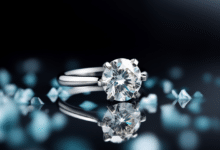4 Powerful Tips for Choosing the Perfect Diamond Engagement Ring

Picture this: You’re down on one knee, heart pounding, as you present the love of your life with the most exquisite diamond ring you could find. Their eyes light up, reflecting the brilliant sparkle of the stone, and you know in that moment, you’ve made the perfect choice. But how did you get there? How did you navigate the dazzling array of options to find the diamond engagement ring that truly captured the essence of your love?
Choosing the perfect diamond engagement ring is a journey, one that requires an understanding of the intricate details that separate a good diamond from a truly exceptional one. In this comprehensive guide, we’ll unravel the mysteries of diamond clarity, carats, polish grades, and shapes, empowering you to make an informed decision that will dazzle for a lifetime.
1. Unveiling the Secrets of Diamond Clarity
When it comes to diamonds, clarity is king. This characteristic refers to the absence of internal inclusions and external blemishes that can affect a diamond’s brilliance and fire. The fewer imperfections a diamond has, the higher its clarity grade, and the more valuable it becomes.
- FL (Flawless): The rarest and most valuable clarity grade, with no internal or external imperfections visible under 10x magnification.
- IF (Internally Flawless): While there may be slight surface blemishes, these diamonds are devoid of any internal inclusions.
- VVS1 and VVS2 (Very, Very Slightly Included): These diamonds contain minute inclusions that are incredibly challenging to spot under 10x magnification.
- VS1 and VS2 (Very Slightly Included): Inclusions in these diamonds are more easily detected under 10x magnification, but they are still considered eye-clean to the naked eye.
“While a flawless diamond may seem like the ultimate prize, it’s essential to strike a balance between clarity and budget,” advises Jared Bilow, a renowned gemologist and owner of JB Jewelers. “Many couples find that a diamond in the VS1 or VS2 range offers exceptional beauty and brilliance while being more affordable.”
2. Carats: The Weight of Love
When it comes to diamonds, size does matter – but not in the way you might think. The carat weight of a diamond is a measure of its mass, not its size. A larger carat weight doesn’t necessarily equate to a more prominent stone, as a diamond’s proportions and cut quality also play a crucial role in its overall appearance.
- 1 carat = 0.2 grams
- Diamonds are typically sold in increments of 0.25 carats (e.g., 0.5, 0.75, 1.0 carats).
- As carat weight increases, so does the rarity and cost of the diamond.
Kaitlyn Bristowe, a renowned influencer and jewelry enthusiast, shares her insight: “While larger diamonds undoubtedly have an allure, it’s important to remember that the carat weight is just one factor. A well-cut, smaller diamond can often appear more brilliant and eye-catching than a larger, poorly cut stone.”
3. The Art of Polish: Unveiling a Diamond’s True Brilliance
A diamond’s polish refers to the smoothness and symmetry of its facets, which greatly impacts its overall brilliance and fire. The better the polish, the more light will reflect and refract within the diamond, creating that mesmerizing sparkle we all love.
- Ideal/Excellent: Perfectly polished facets, reflecting light with maximum brilliance.
- Very Good: Slight imperfections in the polish, but still exhibiting exceptional brilliance.
- Good: Noticeable polish imperfections that may impact the diamond’s overall sparkle.
- Poor: Significant polish imperfections that can negatively affect the diamond’s appearance.
“A diamond’s polish is often overlooked, but it plays a crucial role in determining its overall beauty,” says Melissa Snyder, founder of Rockher Jewelry. “I always recommend looking for a diamond with an ‘Ideal’ or ‘Excellent’ polish grade to ensure maximum brilliance and fire.”
4. The Shape of Your Love: Choosing the Perfect Diamond Cut
While often confused with a diamond’s cut quality, the shape of a diamond refers to its physical outline when viewed from above. From the classic round brilliant to the elegant oval, each shape offers its own unique charm and personality.
- Round Brilliant: The most popular and traditional shape, known for its exceptional brilliance and fire.
- Princess: A modern, square-shaped diamond with incredible sparkle and a contemporary edge.
- Oval: An elongated, elegant shape that can make the diamond appear larger than its actual carat weight.
- Cushion: A romantic, vintage-inspired shape with rounded corners and a soft, timeless appeal.
- Emerald: A rectangular shape with elegant, step-cut facets that highlight the diamond’s clarity and color.
“The shape of a diamond is a deeply personal choice that should reflect the wearer’s style and personality,” advises Kelly Hurliman, a renowned jewelry designer. “Take the time to try on different shapes and let your heart guide you to the one that speaks to you most profoundly.”
Choosing the perfect diamond engagement ring is a journey of love, guided by knowledge and a deep appreciation for the artistry and craftsmanship that goes into each exquisite stone. By understanding the nuances of clarity, carats, polish, and shape, you’ll be empowered to make a decision that will not only dazzle but also stand as a timeless symbol of your love and commitment.












